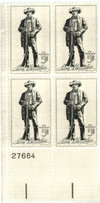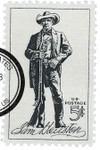
# 1242 - 1964 5c Sam Houston
5¢ Sam Houston
City: Houston, TX
Quantity: 125,995,000
Printed by: Bureau of Engraving and Printing
Printing Method: Rotary Press
Perforations: 10 1/2 x 11
Color: Black
Birth Of Sam Houston
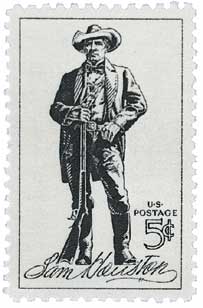
American soldier and politician Sam Houston was born on March 2, 1793, in Rockbridge County, Virginia.
Houston’s family moved to Tennessee when he was 13. There he worked on the family’s farm and in their store. He disliked both of these and ran away when he was 16 to live with a Cherokee tribe. Houston grew close with the tribe’s leader, learned their language, and received the name Raven.
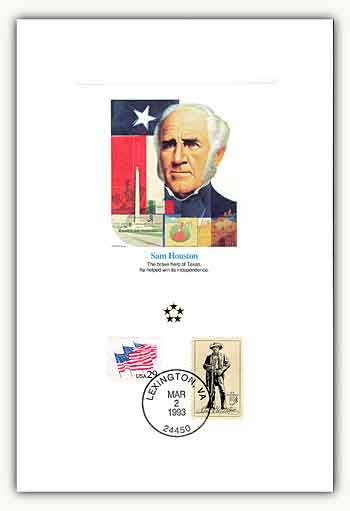
Houston returned home to his family in 1812 and worked as the schoolmaster of a one-room schoolhouse. That same year the War of 1812 broke out and he enlisted in the US Army. Houston quickly impressed his commander, Thomas Hart Benton, and by late 1813 was promoted to third lieutenant. The following year, he fought the Creek Indians under Andrew Jackson’s command and was seriously wounded at the Battle of Horseshoe Bend. Doctors didn’t expect him to survive from his wounds, but he did and was one of the few officers to keep his commission after the war ended.
Houston remained in the Army until 1818, resigning after being reprimanded for wearing Native American clothes to a meeting between Secretary of War John C. Calhoun and Native American leaders. He would continue to serve as a government liaison with Cherokee.
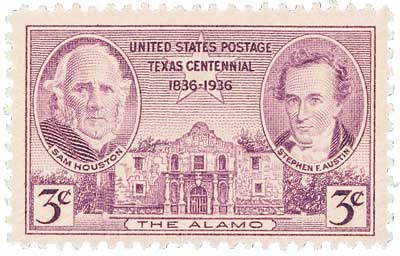
Houston went on to become a lawyer and was elected solicitor general for Nashville in 1819. He was also made adjutant general of the Tennessee militia. Houston went on to serve as a member of the Tennessee House of Representatives before being elected that state’s governor. In that role, he pushed for the building of canals and lowering the price of land for homesteaders. Houston resigned in April 1829 after his marriage fell apart and went to Arkansas Territory to live with the Cherokee.
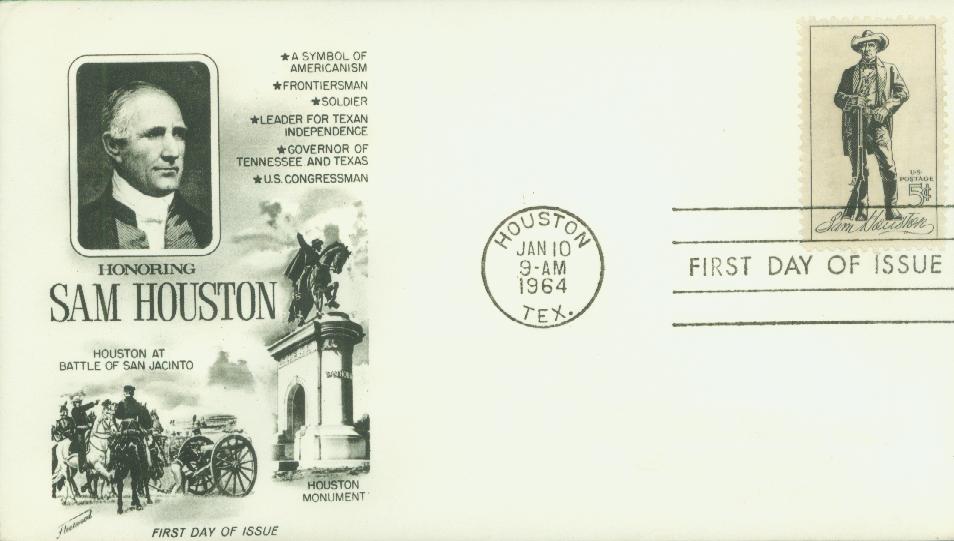
In 1832, some of Houston’s friends encouraged him to visit the Mexican possession of Texas. Mexico had invited Americans to settle there, but over time, they grew unhappy with Mexican rule. Houston arrived in late 1832 and supported Texas statehood. The Texas Revolution broke out in October 1835 and Houston quickly became one of the leaders of the American movement for independence from Mexico. He organized an army and became its commander in chief. In April 1836, he defeated the Mexican army, under the command of General Antonio López de Santa Anna, at the Battle of San Jacinto. Mexico was then forced to recognize Texas as independent.
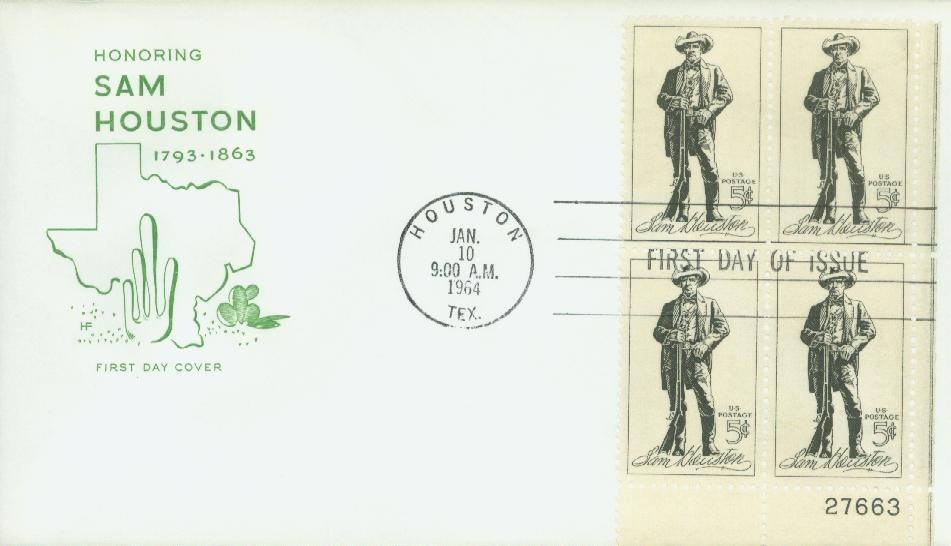
Houston became the first president of the Republic of Texas. He served from 1836-38 and then again from 1841-44. One of his main goals was to have Texas admitted as a US state. Houston succeeded in 1845, and from 1846-59 he served as a Texas senator.
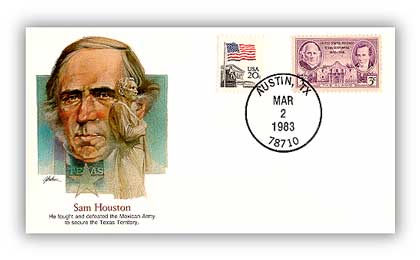
Houston disagreed with many Southern leaders on the issues leading up to the Civil War. In 1859, Houston ran for governor of Texas on a ticket that opposed secession from the Union. However, in 1861, Texas voted to secede. To add to the historical significance, the secession ordinance was written to take effect on March 2, the anniversary of Texas’ declaration of independence from Mexico, as well as Houston’s birthday.
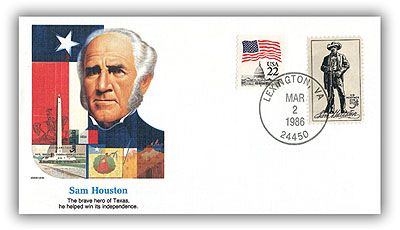
Houston refused to take an oath of loyalty to the Confederacy, for which he was evicted from his position by the legislature. Rather than resist, Houston left his office willingly, saying “I love Texas too well to bring civil strife and bloodshed upon her. To avert this calamity, I shall make no endeavor to maintain my authority…”
Houston retired to private life and passed away two years later, on July 26, 1863. The city of Houston, Texas, founded in 1836, was named in his honor.
5¢ Sam Houston
City: Houston, TX
Quantity: 125,995,000
Printed by: Bureau of Engraving and Printing
Printing Method: Rotary Press
Perforations: 10 1/2 x 11
Color: Black
Birth Of Sam Houston

American soldier and politician Sam Houston was born on March 2, 1793, in Rockbridge County, Virginia.
Houston’s family moved to Tennessee when he was 13. There he worked on the family’s farm and in their store. He disliked both of these and ran away when he was 16 to live with a Cherokee tribe. Houston grew close with the tribe’s leader, learned their language, and received the name Raven.

Houston returned home to his family in 1812 and worked as the schoolmaster of a one-room schoolhouse. That same year the War of 1812 broke out and he enlisted in the US Army. Houston quickly impressed his commander, Thomas Hart Benton, and by late 1813 was promoted to third lieutenant. The following year, he fought the Creek Indians under Andrew Jackson’s command and was seriously wounded at the Battle of Horseshoe Bend. Doctors didn’t expect him to survive from his wounds, but he did and was one of the few officers to keep his commission after the war ended.
Houston remained in the Army until 1818, resigning after being reprimanded for wearing Native American clothes to a meeting between Secretary of War John C. Calhoun and Native American leaders. He would continue to serve as a government liaison with Cherokee.

Houston went on to become a lawyer and was elected solicitor general for Nashville in 1819. He was also made adjutant general of the Tennessee militia. Houston went on to serve as a member of the Tennessee House of Representatives before being elected that state’s governor. In that role, he pushed for the building of canals and lowering the price of land for homesteaders. Houston resigned in April 1829 after his marriage fell apart and went to Arkansas Territory to live with the Cherokee.

In 1832, some of Houston’s friends encouraged him to visit the Mexican possession of Texas. Mexico had invited Americans to settle there, but over time, they grew unhappy with Mexican rule. Houston arrived in late 1832 and supported Texas statehood. The Texas Revolution broke out in October 1835 and Houston quickly became one of the leaders of the American movement for independence from Mexico. He organized an army and became its commander in chief. In April 1836, he defeated the Mexican army, under the command of General Antonio López de Santa Anna, at the Battle of San Jacinto. Mexico was then forced to recognize Texas as independent.

Houston became the first president of the Republic of Texas. He served from 1836-38 and then again from 1841-44. One of his main goals was to have Texas admitted as a US state. Houston succeeded in 1845, and from 1846-59 he served as a Texas senator.

Houston disagreed with many Southern leaders on the issues leading up to the Civil War. In 1859, Houston ran for governor of Texas on a ticket that opposed secession from the Union. However, in 1861, Texas voted to secede. To add to the historical significance, the secession ordinance was written to take effect on March 2, the anniversary of Texas’ declaration of independence from Mexico, as well as Houston’s birthday.

Houston refused to take an oath of loyalty to the Confederacy, for which he was evicted from his position by the legislature. Rather than resist, Houston left his office willingly, saying “I love Texas too well to bring civil strife and bloodshed upon her. To avert this calamity, I shall make no endeavor to maintain my authority…”
Houston retired to private life and passed away two years later, on July 26, 1863. The city of Houston, Texas, founded in 1836, was named in his honor.







